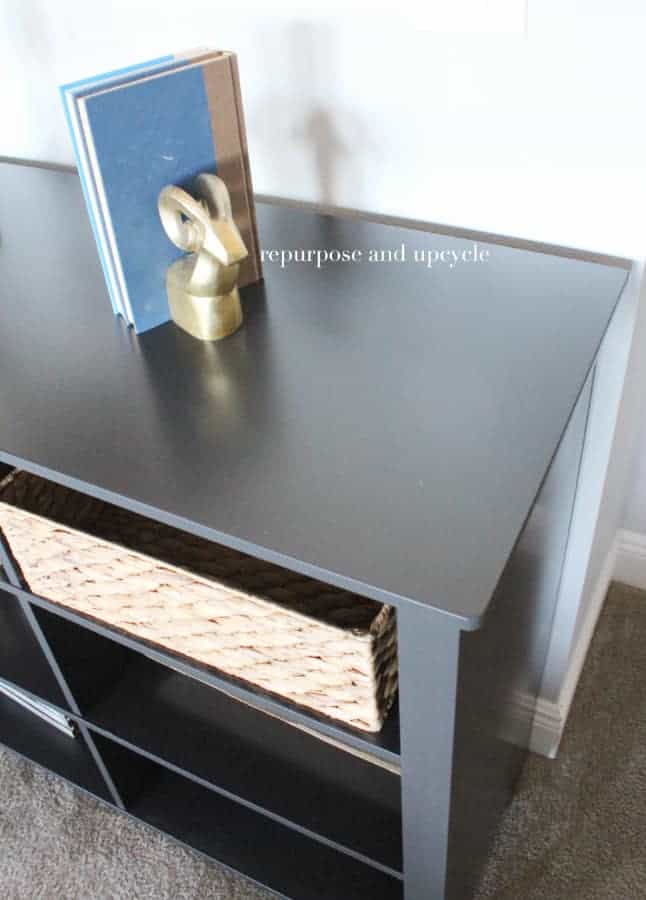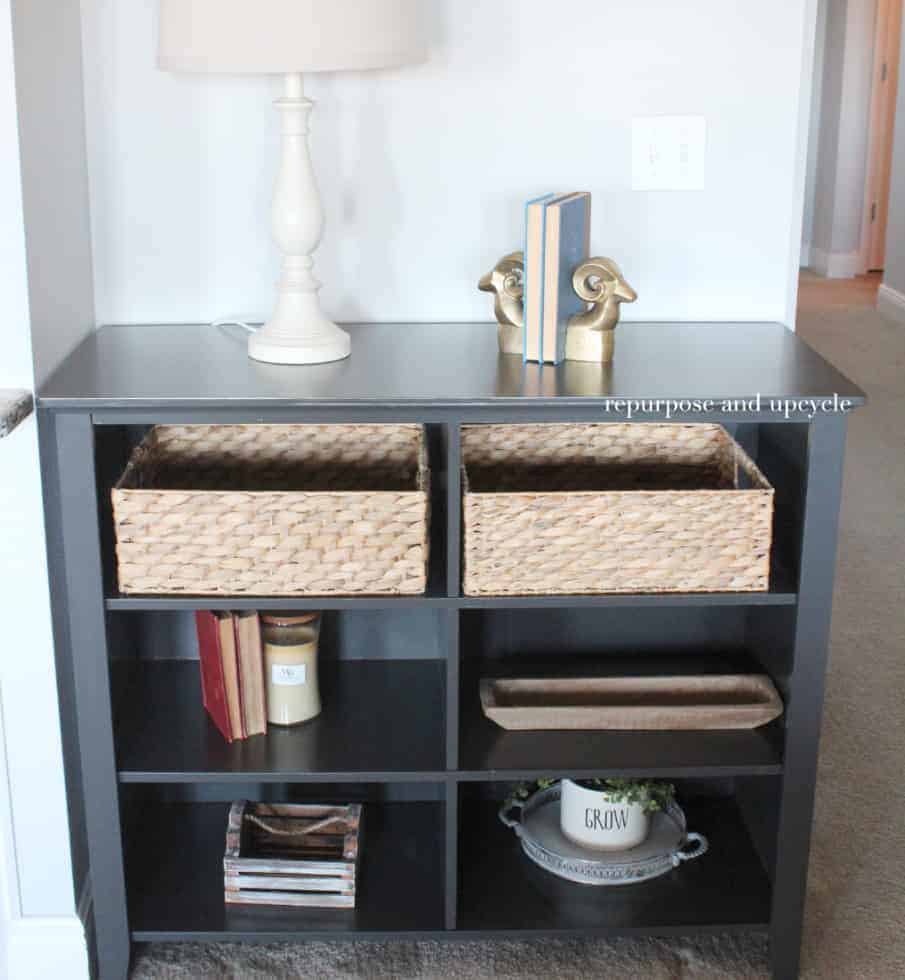Learn how to use chalk spray paint as I transform an old faux wood bookcase. I’ve shared the pros and cons of chalky style spray paint.
I think it’s obvious that I love to paint furniture. From milk paint to acrylic paint, it seems that I’ve tried them all. One type of paint I’ve been itching to try that I haven’t yet is chalk spray paint. I’ve heard mixed reviews about this stuff, so when I was trying to figure out what medium to use to paint an old faux wood bookshelf, I decided I would give a little chalky style spray paint a go!

The bookcase is made from particle board with a faux wood veneer. Because it’s not made of real wood but a plastic like material, I should have used a primer before I used the chalk spray paint.
Rookie mistake
That being said, five years later this spray chalk paint application has held up really well.
P.S. Hindsight I should have followed my “how to paint laminate cabinets and furniture” tutorial.
Let me show you a few before photos of this sad bookcase.


Disclosure; this post contains affiliate links. As an Amazon Associate I earn from qualifying purchases. This disclosure statement refers to the rest of the Amazon links in this post.
I’m not a fan of painting real wood, but when it comes to painting faux wood, anything is game! Since the finish on this bookcase was a cheap faux veneer, I was more than happy to paint it!
I’m going to be honest; I’m a bit of a lazy DIYer. When it came time to paint this bookcase, I pulled out the paint can but realized I didn’t have any brushes.
Then I remembered that I had a few cans of chalky style spray paint! YES!
Rust-Oleum Chalk Spray Paint
Rust-Oleum chalked ultra matte spray paint is my favorite chalky style spray paint to date.
Since I’ve heard mixed reviews about chalky style spray paint, I decided to use it on a bookcase that I wasn’t super attached to. This way if the end product wasn’t to my liking, it would be no big deal to refinish.
Note; if you’ve never used Chalk style paint before it would be a good idea to check out my post all about it before you dive into using the spray paint.
I love this product. I fell in love with grayish navy color. I felt like it would blend perfectly with the rest of my decor. You can purchase this at most hardware stores near the rest of the can chalk paint.
Also, since this post was written, I’ve painted a few more furniture pieces with it too. Check out my coastal style mudroom makeover where I spray painted the top of the mudroom bench AND the shelf with this chalk style spray paint!

How to apply chalky style spray paint
- Lightly sand surface with a fine grit sandpaper if needed (not required)
- Clean the surface and wipe down with a lint free rag
- Shake the can of spray paint to ensure that you get an even mixture
- Start spraying the surface with multiple thin coats and in long even strokes
- I sprayed two full coats of chalk spray paint
- Make sure both coats are completely dry
- Finish it with a chalk wax or a clear coat. My personal choice is Minwax Polycrylic water based in Satin top coat.
You can use a furniture wax, but I have found that the furniture wax does not hold up as well to continued use with lots of little hands (my kids) touching it.
For those that want more details on how to seal chalk paint to last, check out my full tutorial here where I use Polycrylic instead of wax to seal a black chalk painted table top.
I love Polycrylic and I’ve even written a post detailing how I used it to seal furniture for a high traffic use.
For those of you that prefer a video, check out my YouTube video all about how to use Chalk Spray Paint.
Chalk spray paint versus real chalk paint
- Regular chalk paint does not have an odor and is safe to use inside. The spray chalk paint, however, needs to be used in a well ventilated outdoor area. Like any spray paint, it has a very strong odor and is quite toxic.
- Most of the spray chalk paint I’ve seen runs at least $5 per can. If you are planning on painting a lot of furniture, it would be more cost effective to buy regular chalk paint and not the spray can form of chalk paint.
- I do love not having to worry about using or cleaning paint brushes!
- Spraying the finish on was much quicker than painting it on!
- I think the spray chalk paint did create a little smoother finish than if I had painted chalk paint on to the bookcase.
- The spray paint did not seem as thick as the regular chalk paint. I do worry that this means that the paint will chip more easily. Time will tell.
Final thoughts when using the spray paint vs. the paint in a can
The spray chalk paint was a quicker, maybe smoother, method in comparison to using a regular old paint brush and can. The spray chalky paint is, however, more costly and doesn’t cover near as much surface area as one regular can of chalk paint.
I used three full cans of the spray paint to paint this bookcase.

It does look good though, doesn’t it!

I love the smooth, factory like finish.

Final Thoughts about Chalk Spray paint
If you are painting a large surface area (like a piece of furniture), the can chalk paint and paint brush works best. My opinion is that Spray chalk paint is best for painting accessories like lamps and smaller decor items. If you want that spray painted chalk style finish, you might want to try using chalk paint in a paint sprayer!

How to use Chalk Spray Paint

Learn how to use chalk spray paint as I transform an old faux wood bookcase. I've shared the pros and cons of chalky style spray paint.
Materials
- Rustoleum Chalk spray paint in the color Charcoal
- Fine grit sandpaper
- Lint free cloth
- Polycrylic clear coat
- 2" paint brush
Instructions
- Lightly sand the surface with a fine grit sandpaper if needed (not required)
- Clean the surface and wipe down with a lint free rag
- Shake the can of spray paint to ensure that you get an even mixture
- Start spraying the surface with multiple thin coats and in long even strokes
- I sprayed two full coats of chalk spray paint
- Make sure both coats are completely dry
- Finish it with a chalk wax or a clear coat. My personal choice is Minwax Polycrylic water based in Satin top coat.
Notes
The spray chalk paint was a quicker, maybe smoother, method in comparison to using a regular old paint brush and can. The spray chalky paint is, however, more costly and doesn't cover near as much surface area as one regular can of chalk paint.
Thanks for stopping by y’all.
I’m always amazed by the power of paint.
Lindsey**





